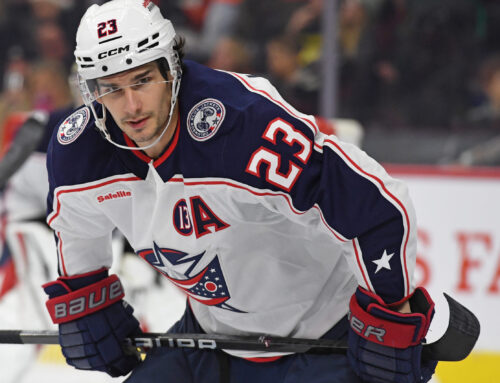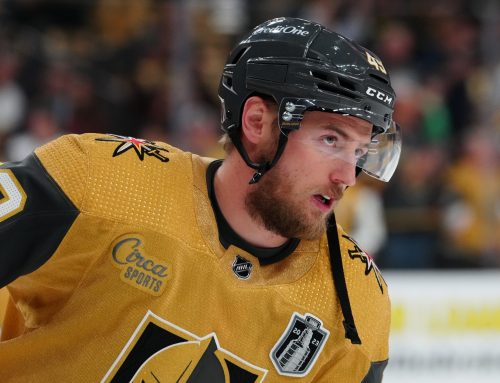Now that the season is finally under wraps (sorry Vancouver/Calgary) it is time to take a look back and see how things panned out. For this mini-series we are going to take each position and see who provided the most value. We will do this by comparing their draft rankings to their performance rankings. Basically, who was worth their draft position?
So how are we going to do this? First up ADP (average draft position). We have ADP from a couple of sites so we are going to combine that and then rank it. So Connor McDavid had the lowest average draft pick (of 1.3) so he gets ranked at #1. Apply that same process across the board and the top three centers are ranked thus:
| ADP Rank | ||
| Connor McDavid | C | 1 |
| Leon Draisaitl | C | 2 |
| Nathan MacKinnon | C | 3 |
No surprises there.
For comparison we are going to take Yahoo's standard calculation for points (six for goal, four for assist, etc.) and apply that to Frozen Tool's Big Board Report. In order to do this, we export the report, then add a little equation adding all of the values for each scoring category. That gives us a total points produced for all players, which we can then rank.
| ADP Rank | PTS Rank | Δ | ||
| Connor McDavid | C | 1 | 1 | 0 |
| Leon Draisaitl | C | 2 | 2 | 0 |
| Nathan MacKinnon | C | 3 | 4 | -1 |
So in this instance McDavid was the first player off the board, and also ranked the highest in total points. Leon Draisaitl was the second, and had the second highest point totals. Nathan MacKinnon was the third center (and player) off the draft table, but the fourth-ranked forward for points. The delta column shows that there is a discrepancy between his ADP and his rank and the negative means he did not quite live up to expectations (don't worry a '-1' is basically nothing).
So using this process we can answer the question: Which center most outperformed his draft position?
The table below contains the top five players whose points rank exceeded their draft rank.
| ADP Rank | PTS Rank | Δ | ||
| Vincent Trocheck | C | 264 | 54 | 210 |
| Kevin Hayes | C | 277 | 103 | 174 |
| Joe Pavelski | C | 192 | 23 | 169 |
| Martin Necas | C | 249 | 80 | 169 |
| Nick Schmaltz | C | 286 | 123 | 163 |
I think the moral of this story is there was some real gold at center at the end of the draft this season. Vincent Trocheck and Joe Pavelski in particular ranked very well in their total points rank.
Trocheck managed to rank as the 54th-highest pointing player even though he missed some time this season. His .91 points per game was the highest of his career. He saw increases in his power-play time, his total time on ice, and his shot rates over his 2019-20 numbers. All of these things look great for being able to sustain success next season, though a 75-point pace might be the high-water mark as his 13.5 shooting percentage is quite a bit higher than his recent career numbers.
On the flip side there were some picks that really didn't work out for managers. The below table shows the reverse of the above, the players who lost the most ranks between their draft and the actual production.
| ADP Rank | PTS Rank | Δ | ||
| Jack Eichel | C | 6 | 206 | -200 |
| Elias Pettersson | C | 19 | 190 | -171 |
| Evgeni Malkin | C | 26 | 158 | -132 |
| Dylan Strome | C | 98 | 196 | -98 |
| Robert Thomas | C | 146 | 231 | -85 |
As the fifth-drafted center Jack Eichel was clearly a top target for teams. It just as clearly did not work out. Injuries definitely hampered some of his production, and same goes for Evgeni Malkin and Elias Pettersson. That leaves Dylan Strome and Robert Thomas to have just disappointed the old-fashioned way then.
Looking at these ranks doesn't tell the full story though – as we will shortly see.
With the full season data, we can compare all players' draft position to their end of year points and produce a trend line. With this line we can take any draft position and get an expected number of points. A player's true points then will give us an idea of how much they performed above or below expected.
The reason for looking at it this way and not just by pure rankings should be immediately evident.
| Expected Pts | PTS | PTS Δ | ||
| Connor McDavid | C | 391.0 | 740 | 349.0 |
| Leon Draisaitl | C | 389.8 | 613.2 | 223.4 |
| Joe Pavelski | C | 229.6 | 421.1 | 191.5 |
| Auston Matthews | C | 386.9 | 571.8 | 184.9 |
| Vincent Trocheck | C | 169.7 | 352.7 | 183.0 |
This top five list contains a couple of the same names as the top ranks list (Vincent Trocheck and Joe Pavelski), but it highlights just how much of a monster season McDavid had. His 349 points above expected is a full 125 points above his next closest competition (Just as a point of reference there were eleven drafted centers who did not get 125 points over the entire season). We aren't going to spend a lot of time going into the brilliance of McDavid, but is just worth pointing out that even though he was drafted first, he not only met that billing, but exceeded it in a pretty dramatic way – even compared to the other superstars in Draisaitl and Auston Matthews who were also drafted in the top five.
A quick minute on Pavelski. His 75-point pace is his highest point pace since 2012-13 and more than double his 38-point pace 2019-20 pace. A huge part of that success was the 21 points he got on the power-play. Much of that came at an unsustainable pace, and add to that his personal and five-on-five percentages are among the highest of his career, it means a fair amount of this production might not have been sustainable, but anyone who took a chance on him early in the season had a great full season add.
Again, if we flip the script, we have our most disappointing players.
| Expected Pts | PTS | PTS Δ | ||
| Jack Eichel | C | 385.0 | 148.9 | -236.1 |
| Quinton Byfield | C | 220.5 | 12.1 | -208.4 |
| Elias Pettersson | C | 373.1 | 170.7 | -202.4 |
| Jonathan Toews | C | 196.6 | 0 | -196.6 |
| Robert Thomas | C | 259.8 | 73.8 | -186.0 |
Eichel, Pettersson, and Jonathan Toews are hurt by being injured, or you know, not playing this season. Quinton Byfield had some hype, but didn't end up making the team for the season. That leaves us with Robert Thomas.
Thomas also had some hype going into the season – though maybe a more accurate statement would be managers were hoping that this would finally be the year. Turns out it wasn't. He got an occasional turn of good deployment, but wasn't able to turn it into sustained success. On the plus side he increased time on ice over the course of the season, gaining about a minute on average. The bad news is that average is still down almost a minute from the 2019-20 season. At this point it really seems like something is going to need to change in St. Louis in order to for Thomas to make his mark.
That is all for this week. Thanks for reading. Stay safe out there.
Help make hockey accessible for everyone. Start by supporting:





 EDM
EDM STL
STL ANA
ANA BUF
BUF DET
DET NYI
NYI MIN
MIN CAR
CAR VAN
VAN
